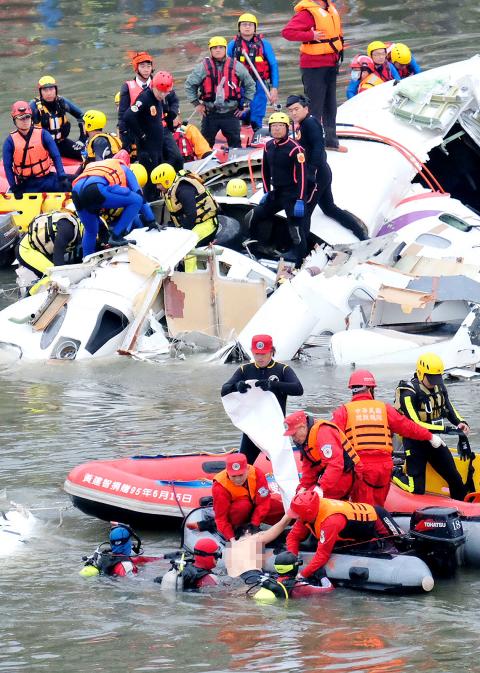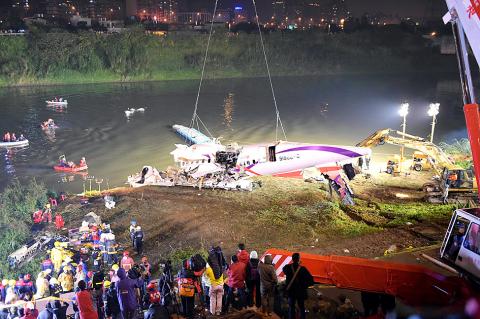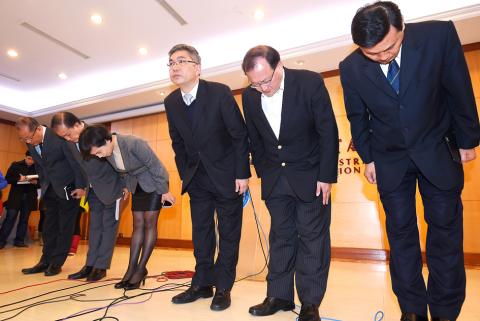A TransAsia Airways (復興航空) airplane flying from Taipei to Kinmen crashed into the Keelung River yesterday, killing at least 25 people, the Civil Aeronautics Administration (CAA) said.
Flight GE235 took off from Taipei International Airport (Songshan airport) at 10:52am, said the agency, which confirmed that it received a “Mayday” signal from the plane’s pilots at 10:53:35am.
Air traffic control personnel tried raising the pilots, but to no avail. Weather data provided by the control tower showed that visibility was 10km when the plane, an ATR 72-600, departed from Songshan airport.

Photo: Sam Yeh, AFP
The weather was quite stable, the CAA said.
The Aviation Safety Council, which is in charge of investigating the cause of the accident, said that it had found the flight data recorder and cockpit voice recorder — also known as the “black boxes” — and would soon start decoding the data.
The data are critical in identifying the cause of the air crash.

Photo: AFP
The plane was carrying 58 people on board: 53 passengers and five cabin crew members.
Thirty-one of the passengers are Chinese tourists, and 27 are Taiwanese. The plane was jointly piloted by 42-year-old Liao Chien-tsung (廖建宗) and 45-year-old Liu Tse-chung (劉自忠), with 4,914 hours and 6,922 hours of flying experience respectively.
Hong Bing-chung (洪炳衷), the copilot, served as an observer during flight as he was training to operate ATR 72-600 aircraft.

Photo: Liao Chen-huei, Taipei Times
Both Liao and Liu are experienced in flying ATR 72-type aircraft, with their flying hours topping 3,400 and 6,500 respectively.
The accident yesterday is TransAsia’s second crash within a year’s time. One of the airline’s ATR 72-500 aircraft crashed on July 23 last year at a village near Magong Airport in Penghu County, killing 48 people and injuring 10 people on board.
TransAsia management bowed and apologized to the victims and their families.
CEO Peter Chen (陳欣德) said that seven of the Taiwanese passengers purchased their tickets at Songshan airport’s check-in counters and only left their ID numbers, adding that the company was still trying to reach the families of the seven passengers.
Ten of the Taiwanese passengers are from Kinmen, he said.
Chen said the Chinese passengers were traveling with the Kaohsiung-based travel agencies Flying Tours (飛揚旅行社) and Sweet Tour (德運旅行社), in cooperation with agencies in Xiamen, China.
TransAsia has asked the travel agencies to help contact the families of the victims, Chen said.
Chen said the company would not speculate on the cause of the air crash, and would fully cooperate with the authorities in the investigation.
The company confirmed that the airplane’s No. 1 engine was replaced with a new one provided by the manufacturer, Pratt & Whitney Canada, when the plane first landed in Macau on its way to Taiwan. The No. 1 engine had only been in operation for 800 hours, the company said.
Chen said the ATR 72-600 aircraft were purchased to replace the company’s ATR 72-500 airplanes as part of its move to upgrade its fleet.
Yu Yi-shi (喻宜式), deputy director of the CAA’s flight standards division, said that Uni Air (立榮航空) has 12 ATR 72-600 planes, while TransAsia has six ATR 72-500s and four ATR 72-600s.
He said that all of the nation’s ATR 72-type airplanes will undergo special inspection in the next two days.
“Because the accident happened with TransAsia’s airplanes, the airline is given one night to complete all the examinations before their aircraft could be cleared to take off on Feb. 5, including engines, propellers. Uni, on the other hand, must finish the same process before Feb. 6,” Yu said.
Information from both the CAA and TransAsia showed that the airline received the aircraft on April 14 last year, with the last maintenance being done on Jan. 26.
Meanwhile, the Environmental Protection Administration (EPA) responded shortly after the crash to address possible fuel leakage.
EPA Department of Environmental Monitoring and Information Management Director-General Chu Yu-chi (朱雨其) said his agency had deployed four survey sites along the section of the river between Nanhu Bridge (南湖大橋) and Minquan Bridge (民權大橋), where the accident took place, to monitor water quality within a 5km stretch along the Keelung River every two hours.
The EPA has also requested help from the Taipei City and New Taipei City governments to deploy two fuel locks under the Rainbow (彩虹橋) and Chengmei (成美橋) bridges to contain possible leakage and driftage, Department of Water Quality senior specialist Wei Wen-yi (魏文儀) said.
Additional reporting by Sean Lin

‘WIN-WIN’: The Philippines, and central and eastern European countries are important potential drone cooperation partners, Minister of Foreign Affairs Lin Chia-lung said Minister of Foreign Affairs Lin Chia-lung (林佳龍) in an interview published yesterday confirmed that there are joint ventures between Taiwan and Poland in the drone industry. Lin made the remark in an exclusive interview with the Chinese-language Liberty Times (the Taipei Times’ sister paper). The government-backed Taiwan Excellence Drone International Business Opportunities Alliance and the Polish Chamber of Unmanned Systems on Wednesday last week signed a memorandum of understanding in Poland to develop a “non-China” supply chain for drones and work together on key technologies. Asked if Taiwan prioritized Poland among central and eastern European countries in drone collaboration, Lin

The Chien Feng IV (勁蜂, Mighty Hornet) loitering munition is on track to enter flight tests next month in connection with potential adoption by Taiwanese and US armed forces, a government source said yesterday. The kamikaze drone, which boasts a range of 1,000km, debuted at the Taipei Aerospace and Defense Technology Exhibition in September, the official said on condition of anonymity. The Chungshan Institute of Science and Technology and US-based Kratos Defense jointly developed the platform by leveraging the engine and airframe of the latter’s MQM-178 Firejet target drone, they said. The uncrewed aerial vehicle is designed to utilize an artificial intelligence computer

Renewed border fighting between Thailand and Cambodia showed no signs of abating yesterday, leaving hundreds of thousands of displaced people in both countries living in strained conditions as more flooded into temporary shelters. Reporters on the Thai side of the border heard sounds of outgoing, indirect fire yesterday. About 400,000 people have been evacuated from affected areas in Thailand and about 700 schools closed while fighting was ongoing in four border provinces, said Thai Rear Admiral Surasant Kongsiri, a spokesman for the military. Cambodia evacuated more than 127,000 villagers and closed hundreds of schools, the Thai Ministry of Defense said. Thailand’s military announced that

CABINET APPROVAL: People seeking assisted reproduction must be assessed to determine whether they would be adequate parents, the planned changes say Proposed amendments to the Assisted Reproduction Act (人工生殖法) advanced yesterday by the Executive Yuan would grant married lesbian couples and single women access to legal assisted reproductive services. The proposed revisions are “based on the fundamental principle of respecting women’s reproductive autonomy,” Cabinet spokesperson Michelle Lee (李慧芝) quoted Vice Premier Cheng Li-chiun (鄭麗君), who presided over a Cabinet meeting earlier yesterday, as saying at the briefing. The draft amendment would be submitted to the legislature for review. The Ministry of Health and Welfare, which proposed the amendments, said that experts on children’s rights, gender equality, law and medicine attended cross-disciplinary meetings, adding that